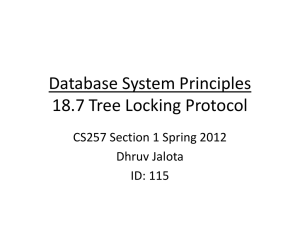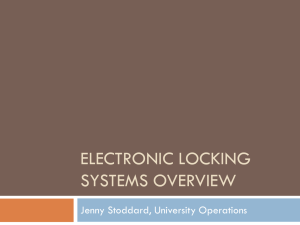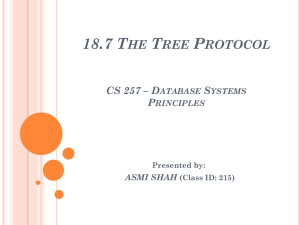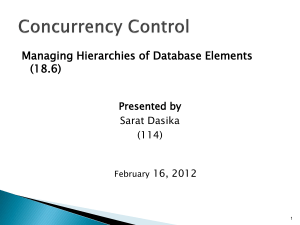PL SQL Security
advertisement
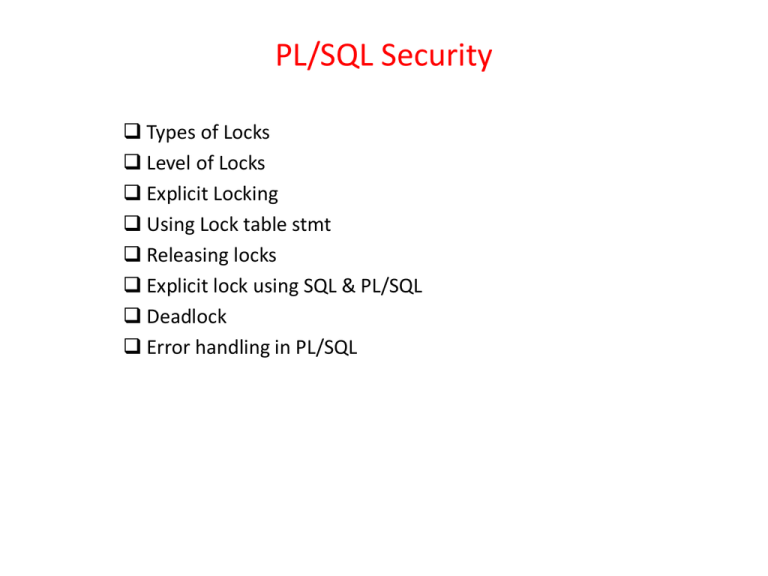
PL/SQL Security
Types of Locks
Level of Locks
Explicit Locking
Using Lock table stmt
Releasing locks
Explicit lock using SQL & PL/SQL
Deadlock
Error handling in PL/SQL
Locks
Locks : Locks are mechanisms used to ensure data integrity while
allowing maximum concurrent access of data.
Oracle locking is fully automatic & requires no user
intervention.
The oracle engine(server machine)locks table data while
executing SQL stmt.This type of locking is called “implicit
locking”.
Oracle default locking strategy is implicit locking.
Since the oracle engine has a fully automatic strategy ,it has to
decide on two issues:1)Types of lock to be applied.
2)Level of lock to be applied.
• Types of Lock: Shared Locks
Exclusive Locks
1)Shared Locks:a)Shared locks are placed on resource whenever a READ
operation(select)is performed.
b)Multiple shared locks can be simultaneously set on a resource.
2)Exclusive Locks:a)Exclusive locks are placed on resource whenever WRITE
operations (Insert, Update & Delete) are performed.
b)Only 1 exclusive lock can be placed on a resource at a time.
• Level Of Locks:A table can be decomposed into rows & a row can be further
decomposed into fields.
1)Row Level
2)Page Level
3)Table Level
1)Row Level:-If the Where clause evaluates to only one row in
the table.
2)Page Level:- If the Where clause evaluates to a set of data.
3)Table Level:- If there is no Where clause(i.e. the query accesses
the entire table).
• Explicit Locking:The technique of lock taken on a table or its resources by a user
is called “Explicit Locking”.
Who can Explicitly Lock?
Users can lock tables they own or any table on which they have
been granted table privilege(select ,insert, update , delete)
Table or rows can be explicitly locked by using either the select
…for update stmt. Or Lock table stmt.
The select …. For Update statement:This clause is generally used to signal the oracle engine that data
currently being used needs to be updated.
• Ex:-Two client machines client A & client B are recording the
transaction performed in a bank for a particular account no.
simultaneously.
• Client A fires the following select statement:
• Client A>select * from acct_mstr where acct_no=‘Sb9’ for
update;
• When the above select statement is fired the oracle engine
locks the record ‘sb9’. This lock is released when a commit or
rollback is fired by client A
• Now client B fires a select stmt.,which points to record sb9
• Using Lock table stmt:Purpose:• Use the LOCK TABLE statement to lock one or more tables,
table partitions, or table sub partitions in a specified mode.
This lock manually overrides automatic locking and permits or
denies access to a table or view by other users for the
duration of your operation.A LOCK is a mechanism that
prevents destructive interaction between two simultaneous
transactions or sessions trying to access the same database
object.
Syntax:LOCK TABLE<TableName>[,<TableName>]…
IN{ROW SHARE|ROW EXCLUSIVE|SHARE UPDATE|
SHARE|SHARE ROW EXCLUSIVE|EXCLUSIVE}
[NOWAIT]
lock mode Clause
Specify one of the following modes:
• ROW SHARE ROW SHARE permits concurrent access to the locked table but prohibits users
from locking the entire table for exclusive access. ROW SHARE is synonymous with SHARE
UPDATE, which is included for compatibility with earlier versions of Oracle Database.
• ROW EXCLUSIVE ROW EXCLUSIVE is the same as ROW SHARE, but it also prohibits locking in
SHARE mode. ROW EXCLUSIVE locks are automatically obtained when updating, inserting, or
deleting.SHARE UPDATE See ROW SHARE.
• SHARE SHARE permits concurrent queries but prohibits updates to the locked table.
• SHARE ROW EXCLUSIVE SHARE ROW EXCLUSIVE is used to look at a whole table and to allow
others to look at rows in the table but to prohibit others from locking the table in SHARE
mode or from updating rows.
• EXCLUSIVE EXCLUSIVE permits queries on the locked table but prohibits any other activity on
it.
• NOWAIT
• Specify NOWAIT if you want the database to return control to you immediately if the
specified table, partition, or table sub partition is already locked by another user. In this case,
the database returns a message indicating that the table, partition, or sub partition is already
locked by another user.
• If you omit this clause, then the database waits until the table is available, locks it, and
returns control to you.
• Example:The following statement locks the employees table in exclusive
mode but does not wait if another user already has locked the
table:
LOCK TABLE employees IN EXCLUSIVE MODE NOWAIT;
Output:Table Locked.
• Releasing locks:All locks are released under the following circumstances:
1)The transaction is committed successfully.
2)A rollback is performed
3)A rollback to a savepoint will release locks set after the
specified savepoint.
Note:- commit:-Save Work done.
Savepoint: Identify a point in a transaction to which you can later
rollback.
Rollback: Restore database to original since the last COMMIT
GRANT/REVOKE: Grant or back permission to or from the oracle
users.
• Explicit lock using SQL & PL/SQL:-
• Deadlock:• A deadlock is a condition where two or more users are waiting for
data locked by each other. Oracle automatically detects a deadlock
and resolves them by rolling back one of the statements involved in
the deadlock, thus releasing one set of data locked by that
statement. Statement rolled back is usually the one which detects
the deadlock.
Example:Transaction1
BEGIN
UPDATE ACCT_MSTR SET CURBAL=500 WHERE ACCT_NO=‘SB1’;
UPDATE ACCT_MSTR SET CURBAL=2500 WHERE ACCT_NO=‘CA2’;
END
Transaction2:
BEGIN
UPDATE ACCT_MSTR SET CURBAL=5000 WHERE ACCT_NO=‘CA2’;
UPDATE ACCT_MSTR SET CURBAL=3500 WHERE ACCT_NO=‘SB1’;
END
Assume that TR1 & TR2 begin exactly at the same time.by default Oracle
automatically places exclusive lock on data that is being updated.This causes
TR1 to wait for TR2 to complete but in turn TR2 has to wait for TR1 to
complete.
• Error handling in PL/SQL
when <exception name> then
user defined actions to be carried out;
• Types Of Exceptions:
1. predefined exceptions:
They are raised automatically by the system during run
time.
2. user defined Exceptions:
They must be raised explicitly using Raise
statement.
